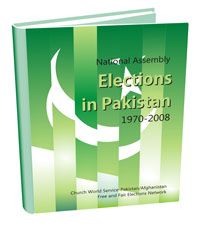ISLAMABAD, August 5, 2010: High turnout, incidents of fraudulent voting, suspicious voting patterns at 18 booths of 15 polling stations and heavy presence of police and security officials inside polling stations marked the by-election for the NA-155 constituency of the National Assembly [Lodhran-II], reports the Free and Fair Election Network (FAFEN) in its Preliminary Report of NA-155 By-Election Observation.
The seat was vacated due to the resignation of Mr. Hayatullah Khan Tareen (Member of National Assembly), who won the 2008 General Elections on a PPPP ticket by securing 50,490 votes when the voter turnout remained 65%. As many as 272,048 voters are registered in NA-155 (Lodhran-II) – 156,075 male and 115,973 female. There were 1,358 less voters registered for the by-election as compared to the registered voters for 2008 general election.
The Election Commission of Pakistan (ECP) had set-up 312 polling stations – 55 male, 55 female, 202 combined polling stations. The 312 polling stations had 681 polling booths – 370 male and 311 female.
FAFEN deployed 39 trained observers on Election Day to monitor more than 60 percent of the polling stations set up in the constituency. Observers spent between 45 and 60 minutes in each polling station to document their observations and findings on a standardized checklist that is based on the provisions of the Representation of the Peoples Act 1976, Conduct of Elections Rules 1977, and instructional handbooks that the ECP has provided to election officials.
This preliminary report is based on observation of 127 polling stations – 32 male, 27 female and 68 combined. Some of FAFEN’s key findings include:
1. Suspicious Voting Patterns
There were 18 polling booths at 15 polling stations where FAFEN observers recorded suspicious voting patterns. If the polling is most efficient and each voter is taking approximately a minute and 30 seconds for processing (checking of name, checking of CNIC, issuance of ballot paper, going behind secrecy screen, stamping a ballot and returning of stamp to the assistant presiding officer), there can be approximately 45 votes that can be cast in an hour at a booth. However, the rate of voting was higher than possible at 18 booths of polling stations listed below. The following table gives booth-wise average of polled votes per hour. An average higher than 45 brings into question the speed with which the voters were being processed.
|
PS. No. |
Registered Voters |
Type |
Time of Observation |
Hourly Average of Polled Votes at Booth |
Hourly Average of Polled Votes at Booth 2 |
Hourly Average of Polled Votes at Booth 3 |
Hourly Average of Polled Votes at Booth 4 |
Total Votes Polled at Time of Observation |
|
PS-1 |
1048 |
M |
1100 |
67 |
33 |
0 |
0 |
300 |
|
PS-43 |
761 |
C |
1300 |
20 |
52 |
0 |
0 |
359 |
|
PS-101 |
820 |
C |
1300 |
48 |
34 |
0 |
0 |
410 |
|
PS-130 |
1134 |
M |
1300 |
52 |
28 |
11 |
0 |
455 |
|
PS-132 |
1261 |
C |
1000 |
25 |
50 |
0 |
0 |
150 |
|
PS-145 |
850 |
C |
900 |
56 |
46 |
0 |
0 |
102 |
|
PS-148 |
1086 |
M |
1200 |
36 |
48 |
0 |
0 |
336 |
|
PS-180 |


